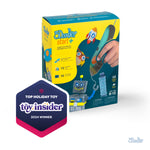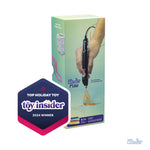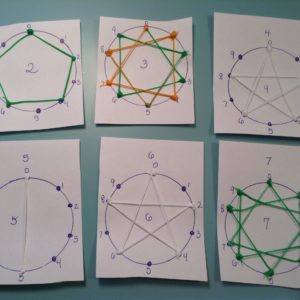MATH: Doodle-Counters (Counting & Number Correspondence)
In this activity, students will practice counting, while creatively reinterpreting the numbers 1-10 as doodled animals, people, or objects, and drafting a related drawing that demonstrates one-to-one correspondence for each number.
*By substituting higher numbers, this same activity can be used with first and second grade students.

KnowledgeStudents havepracticed with the 3Doodler.
had practice drawing straight lines, outlines and fill with the 3Doodler.
practiced counting numbers 1-10.
practiced with the 3Doodler.
had practice drawing straight lines, outlines and fill with the 3Doodler.
practiced counting numbers 1-10.
ObjectivesStudents willcreatively reinterpret a number as an animal, object or person.
draw a stencil for a doodled number.
use a 3Doodler to creatively doodle a number.
draw a related picture that demonstrates an understanding of one-to-one number correspondence.
creatively reinterpret a number as an animal, object or person.
draw a stencil for a doodled number.
use a 3Doodler to creatively doodle a number.
draw a related picture that demonstrates an understanding of one-to-one number correspondence.
MaterialsStudents will need3Doodler (1 per pair)
Doodle-Counting Worksheet (1 per pair)
random counting objects, e.g., blocks, legos, buttons, pennies, etc.
pencil (1 per student)
set of crayons (1 box per 2 students)
white drawing paper (1 per pair)
3Doodler (1 per pair)
Doodle-Counting Worksheet (1 per pair)
random counting objects, e.g., blocks, legos, buttons, pennies, etc.
pencil (1 per student)
set of crayons (1 box per 2 students)
white drawing paper (1 per pair)
Lesson PlanInstructions
Step 1Whole Group: Review counting numbers 1-10.
Step 2Practice one-to-one number correspondence by counting objects, e.g., legos, blocks, buttons, pennies, etc.
Step 3Demonstrate how to creatively reinterpret a number as an object, animal or person. Model how the number 2 can be turned into a duck.
Step 4Step 5Guided practice: Call students up to the board, and have students practice turning numbers into simple objects, animals or people.
Step 6Note that each of these number-drawings can be used as a stencil for a doodle.
Step 7Model how to use the 3Doodler to trace over the lines of a simple number-drawing. Divide larger segments needing fill into smaller more manageable areas. Make sure edges of parts are all connected by plastic.


![]() Step 8
Step 8Assign a number to each pair of students. Instruct them to use their pencils to turn it into an object, person or animal on the Doodle-Counting Worksheet. Review their work before allowing them to doodle. You may need to simplify their drawing.
Step 9Hand out 3Doodlers and circle to assist and assess as students work.
*This activity works best if conducted as a small center activity, or in a whole group with help from an aid or parent-volunteer.
*To make the stand for the doodles, weld each doodle to a rectangular base (rectangular stencils in Doodle-Counting Worksheet.

![]()
![]() Step 10
Step 10Instruct students to draw a related picture that illustrates one-to-one number correspondence.
Example: If a student doodles the number 2 as a duck, then they would draw 2 small ducks on a piece of paper to illustrate the one-to-one correspondence.
Whole Group: Review counting numbers 1-10.
Practice one-to-one number correspondence by counting objects, e.g., legos, blocks, buttons, pennies, etc.
Demonstrate how to creatively reinterpret a number as an object, animal or person. Model how the number 2 can be turned into a duck.
Guided practice: Call students up to the board, and have students practice turning numbers into simple objects, animals or people.
Note that each of these number-drawings can be used as a stencil for a doodle.
Model how to use the 3Doodler to trace over the lines of a simple number-drawing. Divide larger segments needing fill into smaller more manageable areas. Make sure edges of parts are all connected by plastic.


Assign a number to each pair of students. Instruct them to use their pencils to turn it into an object, person or animal on the Doodle-Counting Worksheet. Review their work before allowing them to doodle. You may need to simplify their drawing.
Hand out 3Doodlers and circle to assist and assess as students work.
*This activity works best if conducted as a small center activity, or in a whole group with help from an aid or parent-volunteer.
*To make the stand for the doodles, weld each doodle to a rectangular base (rectangular stencils in Doodle-Counting Worksheet.

Instruct students to draw a related picture that illustrates one-to-one number correspondence.
Example: If a student doodles the number 2 as a duck, then they would draw 2 small ducks on a piece of paper to illustrate the one-to-one correspondence.
Wrap Up
Assessment
Possible Extensions
Vocabulary
acting - the art or practice of representing a character before an audience.
collaboration - to work jointly with others or together especially in an intellectual endeavor.
color - the quality of an object or substance with respect to light reflected by the object, usually determined visually by measurement of hue, saturation, and brightness of the reflected light; saturation or chroma; hue.
counting - to indicate or name by units or groups so as to find the total number of units involved.
drawing - the art or technique of representing an object or outlining a figure, plan, or sketch by means of lines.
number - a unit belonging to an abstract mathematical system and subject to specified laws of succession, addition, and multiplication.
one-to-one correspondence -
problem-solving - the process or act of finding a solution to a problem.
writing - any written or printed paper, as a document or deed.
Educational Standards
Students use numbers, including written numerals, to represent quantities and to solve quantitative problems, such as counting objects in a set; counting out a given number of objects.
Students will doodle numbers, draw related pictures and arrange doodled numbers in their proper sequence.
Understand the relationship between numbers and quantities; connect counting to cardinality.
Students will draw pictures that demonstrate an understanding between the doodled number and its quantity.
When counting objects, say the number names in the standard order, pairing each object with one and only one number name and each number name with one and only one object.
Students will draw a picture that accurately reflects an understanding of their doodled number's one-to-one correspondence. Students will place doodled numbers in the proper sequence and count them.
Decompose (break down) a larger problem into smaller sub-problems with teacher guidance or independently.
Students will break down the process of counting and number correspondence through a process of doodling, drawing, hands-on learning and counting.
Use technology to seek feedback that informs and improves their practice and to demonstrate their learning in a variety of ways.
Students will use the 3Doodler to create doodled models of numbers to enhance their understanding of counting numbers and one-to-one number correspondence.
Exhibit a tolerance for ambiguity, perseverance and the capacity to work with open-ended problems.
Students will demonstrate competency within an open-ended task with more than one possible outcome.
Create original works or responsibly repurpose or remix digital resources into new creations.
Students will use a 3Doodler to creatively reinterpret numbers.
Use collaborative technologies to work with others, including peers, experts or community members, to examine issues and problems from multiple viewpoints.
Students will seek feedback from peers throughout the design and counting process.





